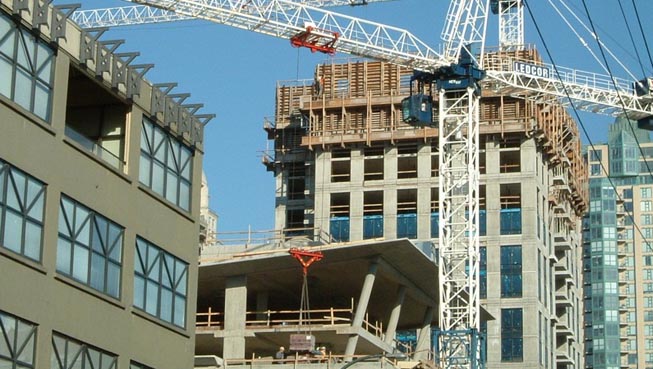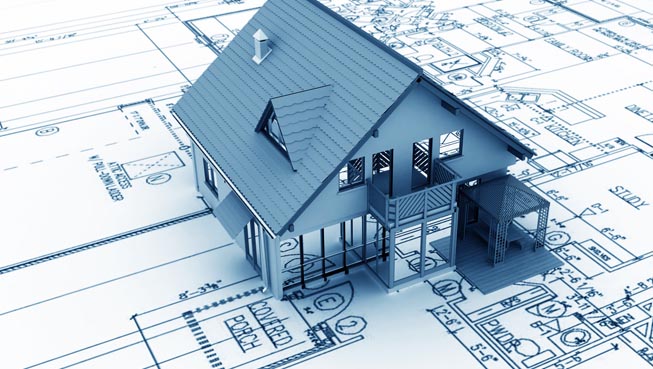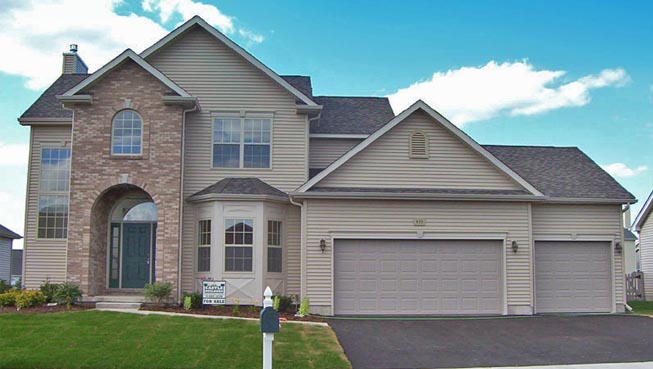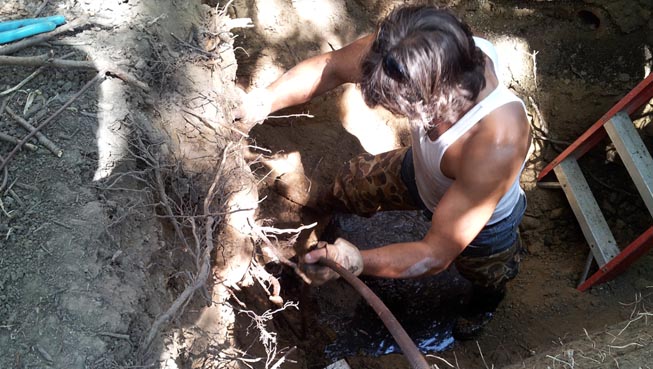Contact
please fill the form to request and inspection job!
Moisture Testing
Moisture Testing Position Paper Mold/Bacteria Sampling
It is the current state of the moisture testing industry that has prompted Acuity to present our opinions so that awareness is raised and better decisions may be made regarding structures and moisture testing in general. Presently, there are many individuals without the basic understanding of construction and building sciences that are utilizing questionable methods to analyze moisture issues in, specifically but not limited to, residential dwellings. Building Diagnostics, with the subset of moisture testing, appears by and large to be a non-regulated industry; therefore, Acuity opines that it is imperative some form of regulation and/or certified training as to the methodologies and the science surrounding moisture testing be implemented.
If the industry continues on this course, its integrity will unquestionably suffer. Technical education that includes an intelligible knowledge of physics, hands-on experience, and the ability to understand and diagnose causal issues is paramount. It is easy to simply state the obvious and make an incorrect or partial analysis; and all too often, it is what you cannot visibly see due to concealed conditions that may be the problem or exacerbating it. As a result, one must clearly understand the causal issues so as to competently make appropriate recommendations to resolve these concerns.
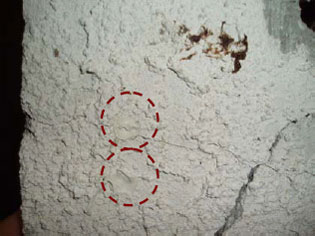
Sealant applied to holes at the stucco subsequent to exterior moisture testing.
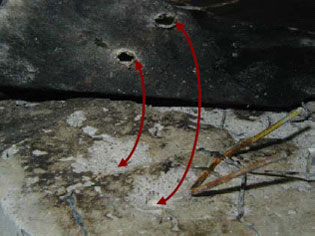
Sealant applied at the stucco subsequent to exterior moisture testing typically does not reach the building paper whereby the drainage plane's integrity is permanently compromised.
As a direct result of news reports bringing to the forefront concerns regarding moisture and structures, specifically regarding stucco systems, there has been an increase in unscrupulous individuals and companies that are attempting to analyze structures for potential moisture issues. Typically, their intent is to make easy money for awhile and then move onto the next scam. Unfortunately, this happens in all types of businesses. Furthermore, other individuals/companies may have good intentions and be reputable in various facets of the construction industry; however, they simply do not have the knowledge, experience, technology, and proper methodology to perform a comprehensive and professional assessment. Still others sell a discounted or even FREE service that is often incomplete (i.e. without the benefit of a written report unless purchased at a 'competitive fee') and does not provide the client with anything of value, specifically if the client chooses to move forward in the direction of a litigious nature. Both of the latter leave the client in basically the same position as the scam artist and none of the three should be in the business of performing moisture testing.
Another disturbing occurrence is when a company performs the moisture testing, remediation phase, and microbial post remediation sampling for the same project. To shift from consultant to contractor and back to consultant is not only a dubious relationship at best but is an obvious conflict of interest and in every respect unprofessional. And lastly, when a consultant makes a general claim such as 'they have not seen a single stucco home less than two years old that does not have a significant area of moisture intrusion', you know that the industry is at risk.
Testing Methods
The methods utilized by various individuals and/or companies can be inconsistent, unreliable, and substandard at best. Moreover, even though some companies may have longevity and are conducting assessments in a particular way does not mean that it is the best way or even correct. Following, is a review of the various methods as well as Acuity's opinions as to the difficulty in analyzing structures even when the best of methods are followed.
The two methodologies utilized are Non-destructive and Destructive testing. Non-destructive testing reveals information about the structure by means that may include visual observations, infrared scans, and surface testing utilizing electronic moisture meters. Unfortunately, information gleaned can be misinterpreted. Conversely, destructive testing may include drilling exterior surfaces to obtain moisture readings at the exterior side of the wall sheathing, or probing interior wall surfaces to obtain moisture levels within the building cavity at the framing, insulation, concrete, and/or the interior side of the wall sheathing. Destructive cuts may also be performed through both the exterior claddings and/or interior wall finishes.
Non-Destructive Testing
Non-destructive infrared scans reveal thermal anomalies NOT moisture. Regarding infrared, one should have a solid understanding of the sciences behind the method; and at the very least, a basic understanding, as follows.
First, the net flow or transfer of heat energy is always from warmer to cooler (The Second Law of Thermodynamics). Heat energy may be transferred in the form of conduction losses that are typically controlled by insulation, convection losses that are controlled by air sealing strategies, and thermal infrared radiation, which is a form of electromagnetic radiation. Furthermore, a rudimentary comprehension of general physics with regard to pressure differentials (i.e. high to low) is helpful as well. Second, each material will change temperature at a different rate and the thermal capacitance of a material describes this rate of change based on the specific heat and density of that material. Thermal capacitance is the physical property of a material's ability to store heat.
Unfortunately, it appears to be this partial knowledge of thermal capacitance that results in untrained individuals often remarking that they can locate water in a structure solely utilizing infrared. While it is true that a wet material will remain warmer longer than its dry counterpart because it contains a greater amount of heat energy and subsequently may be revealed as a thermal anomaly, it is also possible that a thermal anomaly can be due to something all together different. For example, insulation that is missing, installed incorrectly, or has been wet in the past and has dried down may exhibit a similar thermal anomaly as the material that is currently wet. Additional issues that may be causal regarding misinterpreting images include but may not be limited to: multiple contiguous framing materials, Polios and extruded foam sheathings, as well as heating, ventilating, and air conditioning (HVAC) ducts in perimeter walls.
While the infrared camera is a valuable tool, images are often misinterpreted resulting in erroneous analysis. Typically, a final analysis should not be based upon the sole use of infrared, especially if the individual is untrained in Thermograph and the associated sciences. Unfortunately, anyone can buy an infrared camera as they have become more affordable; nonetheless, it takes a trained Thermograph experienced in the building diagnostic industry to interpret the image as well as demonstrate professionalism in realizing that additional destructive testing should be performed to confirm the analysis.
Another non-destructive procedure utilizes electronic moisture meters in surface mode. These moisture meters may read surface values up to approximately ¾ inch to three inches deep in the non-destructive mode. While this method of assessing moisture in building materials may sound good, again, care must be taken regarding the data obtained and how the data is interpreted. Typical issues that can affect a nondestructive moisture meter investigation include, but may not be limited to, wire mesh embedded in traditional stucco cladding, foil faced insulation, exterior and interior metal fasteners (i.e. nails, staples, and screws), change of wall cross section (i.e. wood stud), varying material thickness (i.e. bevel siding), irregular and/or rough surfaces, as well as metal pipes and HVAC ducts in outside wall cavities.
Testing with moisture meters in the non-destructive mode penetrates up to three inches maximum, and wall structure depths may vary from a minimum of 4½ inches to over eight inches in total depth. Utilizing even the finest equipment when analyzing only up to three inches of the wall cavity does not offer the accuracy and reliability needed to professionally assess a structure for moisture issues.
Generally, information obtained when conducting non-destructive stucco analyses utilizing infrared and/or moisture meters in surface mode, specifically on traditional stucco cladding, appears flawed at best and compromises the moisture industry's professionalism. This equipment and method may work fine on Exterior Insulation and Finish Systems (EIFS)—not using metal fasteners; however, the lack of technical education, misunderstanding of the electrical impedance method, as well as inexperience regarding traditional stucco construction virtually renders these instruments and data worthless. Similarly, brick veneer like traditional stucco, does not allow for accurate use of infrared and moisture meters.
Ultrasound is another non-destructive testing method; however, its use in building diagnostics is primarily utilized to identify breaches and open penetrations at building skins (i.e. windows/doors at sidewalls and pipes/flues at rooftops), as well as at plumbing fittings.
Destructive Testing - Exterior
With regard to destructive testing, it can be broken down into two general categories: exterior and interior. Exterior destructive testing and analysis may entail moisture testing utilizing electronic moisture meters with pins and/or probes, as well as cutting and removing cladding to assess potential deterioration at substrates, and/or window installation details.
Testing with moisture meters can vary with the type of exterior cladding that is installed. If there is maintenance free siding (i.e. vinyl, steel, or aluminum), typically the bottom of a piece is unsnapped and readings are taken at the outer side of the exterior sheathing. If a drainage plane (i.e. Tyvek or #15 felt) is in place, care must be taken not to penetrate the drainage plane as well as to reduce the risk of false positive readings due to the likely presence of water draining on the outer side of the drainage plane, which is its purpose. Where bevel siding is installed, typically, longer moisture probes are inserted at the bevel lap and extended to reach the exterior sheathing. Generally, on structures with sheet good sidings, ¼-inch holes are drilled throughout the siding and readings are obtained at the outer side of the sheathing; however, a reading may be obtained at the stud if the siding was installed directly over the studs.
Traditional stucco cladding provides even more of a challenge in obtaining accurate results while maintaining the integrity of the stucco system. It is common practice to drill ¼-inch holes, the majority of which do not appear to exhibit an upward angle, through the stucco skin to reach the sheathing. Unfortunately, Acuity believes that there are serious concerns utilizing this method. First and foremost, stucco is porous and relies on the flashings and drainage plane to keep the wood framed structure dry. To ensure this, the integrity of the flashings and drainage plane should not be sacrificed. The method of drilling a ¼ inch hole through concrete stucco that varies from approximately ¼ inch to over one inch in thickness makes it virtually unfeasible to preserve the drainage plane.
Second, unless the climate is consistently dry with low humidity, the drainage plane is likely to exhibit various degrees of moisture. During exterior destructive testing, probes will come into contact with and penetrate the drainage plane prior to reaching the sheathing. This drainage plane may likely exhibit some degree of wetness, resulting in false elevated moisture readings. Moreover, an integral part of traditional stucco is the wire mesh. Probes coming into contact with this metal will also result in false elevated moisture readings. These two elements will have a direct impact on the final analysis and illustrate why it is unwise and unprofessional to test from the exterior.
Third, it seems common practice for inspectors to report that the sheathing was soft or deteriorated to the point of not being present. This is likely due to forcefully drilling the hard concrete stucco and unknowingly penetrating the insulated sheathing. When a hammer probe is taken to this area and there is no resistance due to the aperture that was created, the incorrect assumption is that the sheathing has rotted away.
Last but certainly not least, a critical reason not to test in this manner is the inability to restore not only the aesthetics of the cladding but more importantly the integrity of the flashings and drainage plane that has now been compromised. In addition, we have found that sealant applied at the open stucco penetrations routinely does not reach the holes made at the drainage plane and if it does, the Expected Useful Life of properly applied exterior grade sealant is approximately seven years with annual monitoring recommended and maintenance as required. Frequently, we have examined stucco clad dwellings that have been tested for moisture utilizing this exterior destructive method and as the stucco is being removed for remediation purposes, we have seldom seen where the sealant has reached the building paper/drainage plane. It has also been our unfortunate experience to witness, based on exterior testing results, unnecessary stucco removal at structures where the sheathing was intact and in sound condition. Again, the practice of exterior moisture testing appears to be common as it is relatively fast with one reading obtained at each test location and therefore inexpensive — up front. Unfortunately, the homeowner just permitted the structure's integrity to be compromised with procuring moisture readings at the outer side of the sheathing, which may be false at that!
Exterior destructive testing/analysis may also entail cutting and removing the cladding to assess window/door installation methods and potential deterioration at material substrates. While this may be justified in isolated instances or as a last resort, we recommend that a Video Scope Investigation be performed first from the interior to ascertain whether or not various locations actually exhibit structural deterioration. Too many exterior cuts have been performed unnecessarily only to reveal that the sheathing and framing are in good condition. Consequently, damage is caused at the structure's weatherproofing.
With regard to utilizing destructive moisture testing on a building clad with Exterior Insulation and Finish Systems (EIFS), we believe that initially EIFS exteriors should be inspected visually and then infrared scans should be performed, weather permitting. Subsequently, the visual and infrared scans should be followed by scans utilizing the Tramex Wet Wall Scanner. Areas exhibiting potential elevated moisture levels should be delineated and tested with probes from the interior so as not to compromise the integrity of the EIFS system. Like traditional stucco, the durability and reliability of an engineered EIFS installation should not be compromised as the result of exterior testing.
Like the moisture meter in the non-destructive mode, caution must be taken when using the Tramex Wet Wall Scanner. There have been reports where an inspector had wrongly stated that an entire structure was 'saturated' and upon further investigation, it was discovered that the cladding was not EIFS but traditional concrete stucco embedded with wire mesh. Structures sheathed with foil faced insulation will also result in false positive readings for moisture, appearing to be wet to the untrained individual.
Destructive Testing – Interior
Contrary to popular belief, not all moisture emanates from the outside of a structure. All too often, it is an unqualified individual that simply states the 'obvious' as the cause of a moisture issue. Yet, it takes a trained professional to not only denote the obvious but to look beyond the obvious and assess the structure comprehensively to determine concerns that may be causal and/or exacerbating the particular problem, as well as other potential concerns. Structures are complex; therefore, many variables including those originating from the interior can affect them and should be investigated.
Destructive moisture testing performed from the interior entails surface probes as well as inserting long probes into the wall cavity, typically through approximately 1/8 inch diameter holes. Tests should be conducted at walls below window corners, mullions, adjacent to the bottom of doors, and in areas that indicate issues of concern from an infrared scan and/or exterior/interior visual assessments. Lower wall sections should also be tested when sufficient ground clearance is not provided between the grade and exterior cladding as well as when there is a flat/negative grade adjacent to the structure. At each location tested, four moisture readings are typically recorded for the surface of the wall covering, the side of the stud, the insulation throughout the cavity, and at the exterior sheathing. Upon removal of the long probes, a silicone based sealant is injected into the aperture. This is easily performed and closes up the vapor barrier. Unlike sealant applied at the exterior, the EUL of interior applications are not diminished as a result of weather.
To minimize the number of testing locations at walls, access may be obtained through electrical receptacles if they are located within three inches of a vertical line extending below window corners and/or mullions. Care should be taken to avoid buried electrical and media cables as well as foil faced insulation. Plaster walls may be drilled with either one or two 3/16 inch holes when utilizing a structural hygrometer or the probes, respectively. The structural hygrometer is able to record temperature, relative humidity and dew point at various depths within the wall cavity.
Prior to testing, a visual assessment must be conducted at the exterior, including lot and grounds, of the structure. Potential issues of concern should be noted and associated interior locations should be assessed during the interior moisture analysis. Also, weather permitting, an Infrared Analysis may be performed to assess thermal anomalies as well as heat loss for energy efficiency. Areas specifically away from windows and doors should be analyzed to determine potential concerns that warrant moisture testing. Furthermore, a Rooftop Assessment and an Attic Ventilation Analysis should be conducted as they are integral components relative to the overall integrity of the structure. Many concerns that emanate from these locations are often overlooked and can be critical regarding the final analysis.
How the visual observations, infrared scans, and moisture data are interpreted and assembled is vital and separates the unscrupulous or mediocre investigator from the competent professional. Acuity believes that it is how you analyze the information that truly adds value and credibility to the Moisture Survey. Typical moisture industry standards indicate that moisture readings below 17% are in an acceptable range; readings from 17% to 19.9% are in a cautionary range; and, readings over 20% indicate a dangerous concern whereby mold can grow and deterioration at organic building materials may begin. Various industry associations including the National Association of Home Builders and the EIFS Industry Manufacturers Association suggest that moisture readings below 19% are acceptable because that level will not promote decay. Conversely, Acuity believes that this standard may be flawed due to various construction techniques especially in geographical locations where dramatic ranges in climate occur. Structures within each of these climate locals should be judged accordingly. For purposes of this paper, we will use the upper Midwest as our basis for interpreting moisture data.
Minnesota is in a "mixed climate" area that can experience temperature swings from more than 40oF below zero to over 100oF with humidity levels that may vary from below 10% to approaching 100%. With drastic variables such as these, it is imperative that the investigator understand not only the impact of the local weather but the physics as well, relative to a structure so that the moisture analysis can be performed correctly to evaluate and delineate moisture concerns. We have discovered that in our climate zone, wall cavities that are not experiencing any or little moisture should read below approximately 12% moisture. A reading above this should be analyzed on an individual basis based on the variables involved to determine causal issues as well as corrective measure, if any, that should be performed.
Acuity recommends that a Video Scope Analysis be conducted at interior locations exhibiting moisture readings above 20% as well as down to 12%, if necessary. This allows for a safe and discrete analysis of the wall cavity to determine if there is evidence of moisture staining, potential mold growth, deterioration, and/or insect infestation. With the video scope, we have viewed wall cavities with 50% moisture content, perhaps due to a one time water event, without adverse conditions revealed at building materials; equally, we have seen wall cavities with as low as 14% moisture content that have experienced severe deterioration. If there is structural deterioration and the structure is less than 10 years old, the builder and/or their insurance company should be notified. At that time, further examination in the form of window pressure testing and/or exterior cuts may ensue.
Up to this point, traditional stucco cladding has not been mentioned as a causal issue regarding moisture incursion into a structure. In our geographical location, the upper Midwest, it is confounding the number of individuals that believe stucco is to blame for moisture intrusion issues in structures. When designed and installed properly with integral drainage planes and flashings, as well as cured at the correct temperature and speed, stucco is as good as any product on the market. There are very few truly bad products; nevertheless, there are many good products that have been and continue to be installed incorrectly or inadequately. Based upon the aforementioned concerns, Acuity strongly believes that regulation in some form and/or certified training relative to moisture testing methodologies and science be implemented to protect property owners as well as the industry's integrity.



